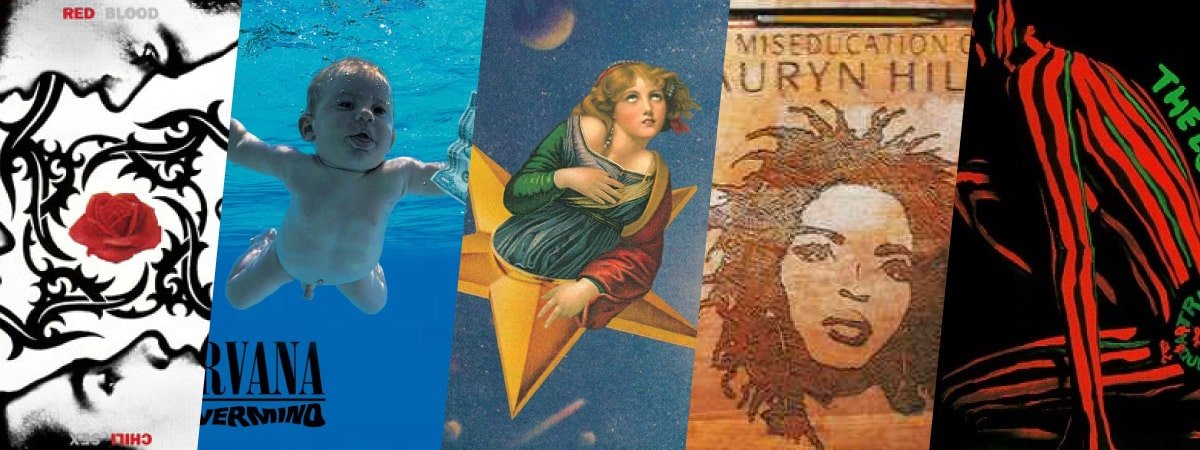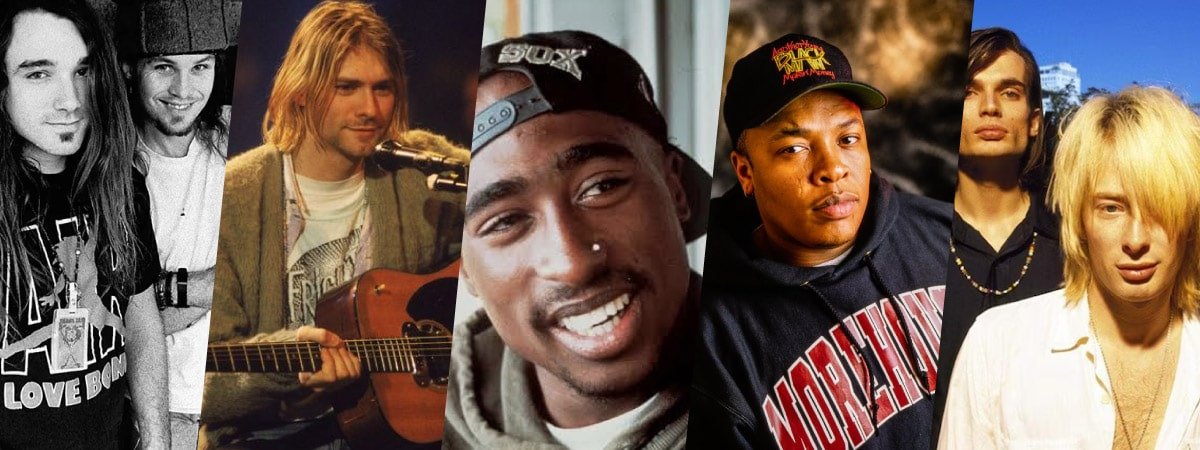Skip to the good bit
ToggleThe ’90s was a golden era for music, giving birth to some of the most iconic albums that continue to influence artists and captivate listeners to this day. From the raw energy of grunge to the innovative sounds of hip-hop, this decade saw an explosion of creativity across genres. We’ve ranked the best albums from the ’90s based on their popularity, impact, and overall quality. Whether you’re revisiting old favorites or discovering these classics for the first time, these albums are essential listening for any music fan.
#30 Loveless – My Bloody Valentine (1991)
“Loveless” was a groundbreaking album that became immensely popular in the ’90s for its innovative approach to guitar sounds and textures. The album’s dense, dreamy, and ethereal soundscapes defined the shoegaze genre, capturing the imagination of listeners and critics alike. My Bloody Valentine’s meticulous production process, characterized by layers of guitar feedback and reverb, created a unique auditory experience that stood out in the era’s musical landscape.
What makes “Loveless” a great album is its ability to evoke deep emotions through its complex and mesmerizing sound. Each track on the album feels like a journey into a sonic dreamscape, where conventional song structures are eschewed in favor of atmosphere and mood. The album’s recording process was notoriously difficult and expensive, nearly bankrupting the band’s label due to the extensive studio time and perfectionism of frontman Kevin Shields.
#29 Homogenic – Björk (1997)
Björk’s “Homogenic” became a staple of ’90s music with its eclectic mix of electronic beats, orchestral strings, and Björk’s distinct vocal style. The album was praised for its bold and experimental approach, blending traditional Icelandic influences with futuristic production. It showcased Björk’s ability to push the boundaries of pop music and carve out a unique niche in the industry.
“Homogenic” is considered great because of its cohesiveness and the depth of its emotional and sonic landscapes. Tracks like “Jóga” and “Bachelorette” feature lush arrangements and deeply personal lyrics, highlighting Björk’s talent as a composer and a storyteller. Björk collaborated with renowned producers like Mark Bell of LFO, who helped shape its innovative sound.
#28 One in a Million – Aaliyah (1996)
Aaliyah’s “One in a Million” was a pivotal album in the ’90s R&B scene, marking her transition from a teenage sensation to a mature artist. The album featured a fresh sound, blending smooth R&B with hip-hop influences, largely thanks to the production work of Timbaland and Missy Elliott. Hits like “If Your Girl Only Knew” and “One in a Million” showcased Aaliyah’s sultry vocals and cemented her status as an R&B icon.
The greatness of “One in a Million” lies in its forward-thinking production and Aaliyah’s unique vocal delivery. The album set a new standard for R&B, influencing countless artists and producers. She was just 17 years old when the album was released, and it solidified her reputation as the “Princess of R&B” while pioneering the genre’s evolution.
#27 Homework – Daft Punk (1997)
Daft Punk’s debut album “Homework” was a game-changer in the electronic music scene, bringing French house to an international audience. The album’s infectious beats and innovative use of sampling made tracks like “Da Funk” and “Around the World” instant hits. “Homework” bridged the gap between underground dance music and mainstream pop, earning Daft Punk critical acclaim and a massive fanbase.
“Homework” is celebrated for its raw and energetic sound, which freshly and timelessly combines elements of house, techno, and funk. The album’s DIY ethos and the duo’s robotic personas added to its mystique and appeal. Interestingly, “Homework” was largely produced in Daft Punk’s home studio, emphasizing their hands-on approach and creative control over their music.
#26 In the Aeroplane Over the Sea – Neutral Milk Hotel (1998)
“In the Aeroplane Over the Sea” by Neutral Milk Hotel became an underground sensation in the ’90s, known for its lo-fi production and emotionally charged lyrics. The album’s surreal storytelling and eclectic instrumentation, including horns and accordion, set it apart from the mainstream. It garnered a cult following and is often cited as one of the decade’s most influential indie rock albums.
This album’s raw, unfiltered emotion and frontman Jeff Mangum’s unique vision make it great. Songs like “Holland, 1945” and the title track are almost mythical, blending personal anguish with historical and fantastical themes. The album draws significant inspiration from Anne Frank’s “The Diary of a Young Girl,” which deeply moved Mangum and influenced the lyrical content.
#25 Blue Album – Weezer (1994)
Weezer’s “Blue Album” was a defining record of the ’90s alternative rock scene, known for its catchy melodies and relatable lyrics. The blue-covered album produced hits like “Buddy Holly,” “Say It Ain’t So,” and “Undone – The Sweater Song,” which became anthems for a generation of disaffected youth. Its straightforward rock sound and nerdy charm resonated widely, making it a commercial and critical success.
The greatness of the “Blue Album” lies in its blend of power pop hooks and emotionally honest songwriting. Frontman Rivers Cuomo’s ability to write introspective yet universally appealing songs set the band apart from their contemporaries. The music video for “Buddy Holly,” directed by Spike Jonze, cleverly spliced the band into footage from the TV show “Happy Days,” boosting the song’s popularity and showcasing the band’s quirky sense of humor.
#24 Different Class – Pulp (1995)
Pulp’s “Different Class” captured the essence of Britpop with its sharp social commentary and catchy, danceable tunes. The album’s breakout single “Common People” became an anthem of the ’90s, reflecting the class struggles and cultural shifts of the time. Jarvis Cocker’s witty lyrics and charismatic delivery made Pulp stand out in the crowded Britpop scene.
What makes “Different Class” a great album is its incisive look at British society combined with infectious melodies and dynamic arrangements. Tracks like “Disco 2000” and “Sorted for E’s & Wizz” showcase the band’s ability to craft both poignant and playful songs. Interestingly, the album cover featured a selection of wedding photos sent in by fans, symbolizing the album’s themes of everyday life and ordinary experiences.
#23 Dummy – Portishead (1994)
Portishead’s “Dummy” was a seminal album in the trip-hop genre. It blended elements of hip-hop, jazz, and electronic music to create a moody, cinematic sound. Tracks like “Sour Times” and “Glory Box” captivated listeners with their haunting melodies and Beth Gibbons’ soulful vocals. The album’s dark, atmospheric vibe set it apart from the more upbeat music dominating the charts then.
“Dummy” is great because of its innovative production and emotional depth. Geoff Barrow’s meticulous sampling and Adrian Utley’s guitar work provided a rich backdrop for Gibbons’ expressive voice. Portishead’s name comes from a small coastal town in England, reflecting their desire to stay grounded and connected to their roots despite their growing fame.
#22 Odelay – Beck (1996)
Beck’s “Odelay” was a genre-blending masterpiece that brought his eclectic style to a wider audience. The album’s fusion of rock, hip-hop, folk, and electronic elements and playful lyrics made them a standout ’90s artist. Hits like “Where It’s At” and “Devils Haircut” showcased Beck’s versatility and creativity, earning him critical acclaim and commercial success.
What makes “Odelay” great is its fearless experimentation and seamless integration of diverse musical influences. Beck’s knack for witty, offbeat lyrics and catchy hooks made the album both thought-provoking and fun. “Odelay” was co-produced by the Dust Brothers, known for their work on the Beastie Boys’ “Paul’s Boutique,” adding another layer of inventive production to the album’s unique sound.
#21 Black on Both Sides – Mos Def (1999)
Mos Def’s “Black on Both Sides” was a landmark album in ’90s hip-hop, celebrated for its intelligent lyrics and socially conscious themes. The album addressed issues like racial identity, police brutality, and the struggles of urban life, resonating deeply with listeners. Tracks like “Ms. Fat Booty” and “Umi Says” highlighted Mos Def’s lyrical prowess and ability to blend personal storytelling with broader social commentary.
The greatness of “Black on Both Sides” lies in its blend of sharp lyricism and innovative production. Mos Def’s ability to tackle serious subjects while maintaining a smooth, engaging flow set the album apart from many of its contemporaries. Mos Def, now known as Yasiin Bey, continued to influence music and acting, showcasing his versatility and commitment to addressing important social issues through his art.
#20 Aquemini – Outkast (1998)
Outkast’s “Aquemini” was a groundbreaking album that pushed the boundaries of hip-hop with its eclectic sounds and introspective lyrics. The album fused funk, soul, and electronic music elements, creating a rich, innovative soundscape. Hits like “Rosa Parks” and “Da Art of Storytellin’ (Part 1)” showcased the duo’s lyrical dexterity and willingness to tackle complex themes.
“Aquemini” is celebrated for its forward-thinking production and the chemistry between André 3000 and Big Boi. The album’s exploration of identity, spirituality, and societal issues resonated with a wide audience, cementing Outkast’s status as one of hip-hop’s most creative forces. The album’s title combines André 3000’s astrological sign (Aquarius) and Big Boi’s (Gemini), symbolizing their contrasting yet complementary styles.
#19 The Low End Theory – A Tribe Called Quest (1991)
“The Low End Theory” by A Tribe Called Quest was a revolutionary album in the ’90s hip-hop scene. It blended jazz influences with clever, socially conscious lyrics, cementing them as a top rap group. Its minimalist production, characterized by deep bass lines and smooth samples, set a new standard for hip-hop aesthetics. Tracks like “Check the Rhime” and “Scenario” showcased the group’s dynamic flow and inventive beats, resonating with critics and fans.
What makes “The Low End Theory” great is its perfect balance between innovation and accessibility. The album’s thoughtful exploration of urban life, identity, and infectious grooves made it a landmark release. Bassist Ron Carter, a legendary jazz musician, played on the track “Verses from the Abstract,” symbolizing the album’s deep connection to jazz heritage.
#18 What’s the Story Morning Glory? – Oasis (1995)
Oasis’ “What’s the Story Morning Glory?” became one of the defining albums of the Britpop movement, with its anthemic tracks and bold, brash attitude. Songs like “Wonderwall” and “Don’t Look Back in Anger” became massive hits, capturing the spirit of the mid-’90s and propelling Oasis to international stardom. The album’s blend of rock and pop melodies and the Gallagher brothers’ charismatic presence made it a cultural phenomenon.
The greatness of “What’s the Story Morning Glory?” lies in its timeless songwriting and its ability to evoke a sense of communal euphoria. The album’s memorable hooks and heartfelt lyrics resonate with listeners today. The recording sessions were famously tumultuous, reflecting the often volatile relationship between Noel and Liam Gallagher, which only added to the band’s legend.
#17 Blood Sugar Sex Magik – Red Hot Chili Peppers (1991)
“Blood Sugar Sex Magik” by Red Hot Chili Peppers was a breakthrough album that showcased the band’s unique fusion of rock, funk, and punk. The album featured hits like “Under the Bridge” and “Give It Away, ” Produced by Rick Rubin,” highlighting the band’s dynamic range and energetic performances. The album’s raw and funky sound captivated a wide audience and solidified the band’s place in rock history.
What makes “Blood Sugar Sex Magik” great is its eclectic mix of musical styles and the band’s uninhibited energy. The album’s lyrical themes, ranging from introspection to exuberance, struck a chord with listeners. The album was recorded in a haunted mansion in Los Angeles, which the band believed contributed to the album’s unique atmosphere and creative vibe.
#16 Enter the Wu-Tang (36 Chambers) – Wu-Tang Clan (1993)
“Enter the Wu-Tang (36 Chambers)” by Wu-Tang Clan was a groundbreaking album in hip-hop history that redefined East Coast hip-hop with its gritty production and raw, unfiltered lyrics. The group’s diverse MC roster, each with a distinct style, created a powerful collective voice. Tracks like “C.R.E.A.M.” and “Protect Ya Neck” became anthems, showcasing the group’s lyrical prowess and innovative beats.
The greatness of “Enter the Wu-Tang (36 Chambers)” lies in its raw authenticity and the introduction of a new, darker sound in hip-hop. The album’s minimalist, sample-heavy production and streetwise lyrics set it apart from the more polished rap of the time.
#15 The Score – Fugees (1996)
“The Score” by Fugees was a critically acclaimed album that blended hip-hop with soul, reggae, and Caribbean influences. Featuring standout tracks like “Killing Me Softly” and “Ready or Not,” the album showcased the group’s versatility and lyrical depth. Lauryn Hill’s powerful vocals and Wyclef Jean and Pras Michel’s dynamic rap styles created a rich, engaging sound.
What makes “The Score” great is its seamless fusion of diverse musical genres and socially conscious lyrics. The album’s production, combining live instrumentation with samples, set a new standard for hip-hop. “The Score” became one of the best-selling hip-hop albums ever, cementing the Fugees’ legacy and launching Lauryn Hill’s successful solo career.
#14 Grace – Jeff Buckley (1994)
“Grace” by Jeff Buckley was a critically acclaimed album that showcased Buckley’s extraordinary vocal range and emotive songwriting. The album featured hauntingly beautiful tracks like “Hallelujah” and “Last Goodbye,” highlighting Buckley’s ability to blend rock, folk, and blues influences into a cohesive and powerful sound. “Grace” became a timeless classic, revered by musicians and fans.
The greatness of “Grace” lies in its emotional intensity and the sheer beauty of Buckley’s voice. The album’s lush arrangements and poetic lyrics create a deeply moving listening experience. Buckley’s cover of Leonard Cohen’s “Hallelujah” became one of the most beloved renditions of the song, elevating both Buckley’s and Cohen’s legacies.
#13 Superunknown – Soundgarden (1994)
Soundgarden’s “Superunknown” was a landmark album in the grunge movement. It featured a heavier, more experimental sound compared to their previous work. The album included hits like “Black Hole Sun” and “Spoonman,” which showcased the band’s musical versatility and Chris Cornell’s powerful vocals. “Superunknown” was critically acclaimed and commercially successful, solidifying Soundgarden’s place in rock history.
What makes “Superunknown” great is its combination of heavy, brooding riffs and intricate, melodic compositions. The album’s dark, introspective lyrics and innovative production made it a standout release in the ’90s. The album’s title was inspired by a misheard lyric from a song by the Seattle band The Melvins, reflecting Soundgarden’s connection to the Seattle music scene.
#12 Siamese Dream – The Smashing Pumpkins (1993)
“Siamese Dream” by The Smashing Pumpkins was a defining album of the ’90s alternative rock scene, known for its lush production and emotional depth. Produced by Butch Vig, the album featured hits like “Today” and “Disarm,” which highlighted Billy Corgan’s introspective lyrics and the band’s dynamic sound. “Siamese Dream” received widespread critical acclaim and commercial success, cementing the band’s status as alt-rock icons.
The greatness of “Siamese Dream” lies in its intricate layering of guitars, emotive melodies, and Corgan’s distinctive voice. The album’s themes of despair and hope resonated with listeners, making it a deeply impactful record. Despite internal tensions and personal struggles during recording, the album became one of the most celebrated works in the band’s catalog.
#11 Dookie – Green Day (1994)
“Dookie” by Green Day was a breakout album that brought punk rock into the mainstream with its catchy hooks and irreverent lyrics. Tracks like “Basket Case” and “When I Come Around” became instant hits, capturing the angst and energy of youth culture in the ’90s. The album’s fast-paced, power-chord-driven sound appealed to a wide audience, making Green Day one of the most popular bands of the decade.
What makes “Dookie” great is its infectious energy and the band’s ability to craft memorable, relatable songs. The album’s raw, straightforward production and Billie Joe Armstrong’s distinctive vocals created a timeless punk sound. “Dookie” won a Grammy Award for Best Alternative Music Album in 1995, solidifying Green Day’s place in rock history.
#10 Automatic for the People – R.E.M. (1992)
“Automatic for the People” by R.E.M. was a critically acclaimed album that showcased the band’s maturity and emotional depth. Featuring hits like “Everybody Hurts” and “Man on the Moon,” the album explored themes of loss, nostalgia, and hope. Its lush arrangements and introspective lyrics resonated with listeners, making it one of the most beloved albums of the ’90s.
The greatness of “Automatic for the People” lies in its thoughtful, poignant songwriting and rich, textured soundscapes. The album’s acoustic and orchestral elements blend to create a timeless, contemplative atmosphere. The album’s title was inspired by a sign at a soul food restaurant in Athens, Georgia, reflecting the band’s roots and connection to their hometown.
#9 Jagged Little Pill – Alanis Morissette (1995)
“Jagged Little Pill” was a landmark album in the ’90s, capturing the raw emotion and angst of a generation. With hits like “You Oughta Know,” “Ironic,” and “Hand in My Pocket,” Alanis Morissette’s candid lyrics and powerful voice resonated with listeners worldwide. The album’s blend of alternative rock and confessional songwriting made it an instant success, selling over 33 million copies globally.
What makes “Jagged Little Pill” great is its fearless honesty and Morissette’s ability to channel personal experiences into universally relatable songs. The album’s exploration of themes like heartbreak, identity, and self-empowerment struck a chord with a diverse audience. Morissette was only 21 years old when the album was released, and it won five Grammy Awards, including Album of the Year.
#8 Ready to Die – The Notorious B.I.G. (1994)
“Ready to Die” was the debut album by The Notorious B.I.G., and it quickly established him as one of the greatest rappers of all time. The album’s gritty narratives and vivid storytelling, showcased in tracks like “Juicy” and “Big Poppa,” painted a raw and realistic picture of life in Brooklyn. Biggie’s smooth flow and compelling lyrics made the album a critical and commercial success.
The greatness of “Ready to Die” lies in its honest portrayal of the struggles and triumphs of urban life, combined with Biggie’s undeniable charisma and lyrical prowess. The album’s production, featuring work by Sean “Puffy” Combs and Easy Mo Bee, provided a perfect backdrop for Biggie’s rhymes. “Ready to Die” was released just three years before Biggie’s untimely death, cementing his legacy as a pivotal figure in hip-hop.
Featured in our best white album covers
#7 Illmatic – Nas (1994)
“Illmatic” by Nas is regarded as one of the greatest hip-hop albums ever. Released when Nas, known for being one of the best rappers ever, was just 20. It features intricate lyrics and vivid storytelling depicting life in the Queensbridge projects. Tracks like “N.Y. State of Mind” and “The World Is Yours” highlight Nas’s poetic talent, earning him critical acclaim.
What makes “Illmatic” great is its combination of Nas’s lyrical genius and the stellar production from legends like DJ Premier, Pete Rock, and Q-Tip. The album’s introspective and reflective nature, paired with its hard-hitting beats, created a timeless masterpiece. “Illmatic” was not an immediate commercial success but grew in stature over the years to become a seminal work in hip-hop.
#6 The Chronic – Dr. Dre (1992)
“The Chronic” was Dr. Dre’s debut solo album and a game-changer for West Coast hip-hop. The album’s G-funk sound, characterized by heavy basslines, melodic synthesizers, and funk samples, became iconic. Tracks like “Nuthin’ but a ‘G’ Thang” and “Let Me Ride” showcased Dre’s production skills and introduced the world to Snoop Dogg.
The greatness of “The Chronic” lies in its innovative production and its influence on the sound of ‘90s hip-hop. The album’s smooth yet hard-hitting beats and Dre’s impeccable production techniques set a new standard in the genre.
#5 Mellon Collie and the Infinite Sadness – The Smashing Pumpkins (1995)
“Mellon Collie and the Infinite Sadness” was an ambitious double album that showcased The Smashing Pumpkins’ musical versatility and grand vision. With hits like “1979,” “Tonight, Tonight,” and “Bullet with Butterfly Wings,” the album explored a wide range of emotions and styles, from orchestral rock to gritty alternative.
What makes “Mellon Collie and the Infinite Sadness” great is its epic scope and the band’s ability to blend diverse musical influences into a cohesive and powerful work. Billy Corgan’s introspective lyrics and the band’s dynamic performances created a rich, immersive experience. The album was nominated for seven Grammy Awards and remains one of the best-selling double albums of all time.
#4 Ten – Pearl Jam (1991)
“Ten” was Pearl Jam’s debut album and a defining record of the grunge era. Featuring hits like “Alive,” “Even Flow,” and “Jeremy,” the album combined raw energy with introspective lyrics, capturing the angst and intensity of the early ’90s. Eddie Vedder’s distinctive voice and the band’s powerful instrumentation resonated deeply with fans.
The greatness of “Ten” lies in its emotional depth and the band’s ability to create anthemic rock songs with lasting impact. The album’s themes of survival, alienation, and hope struck a chord with a generation of listeners.
#3 The Miseducation of Lauryn Hill – Lauryn Hill (1998)
“The Miseducation of Lauryn Hill” was Lauryn Hill’s solo debut and a groundbreaking album that blended hip-hop, R&B, soul, and reggae. With tracks like “Doo Wop (That Thing)” and “Ex-Factor,” Hill’s powerful voice and insightful lyrics addressed themes of love, motherhood, and self-discovery. The album received widespread acclaim and commercial success.
What makes “The Miseducation of Lauryn Hill”, known for its iconic orange feel, great is its profound lyrical content and Hill’s ability to blend different musical styles seamlessly. The album’s raw emotion and authenticity resonated with a broad audience, earning Hill five Grammy Awards, including Album of the Year. An interesting fact about Hill, is that she recorded much of the album while pregnant with her first child, adding a personal depth to the music.
#2 OK Computer – Radiohead (1997)
“OK Computer” by Radiohead was a revolutionary album that redefined alternative rock with its experimental sound and complex themes. Featuring songs like “Paranoid Android” and “Karma Police,” the album explored the impact of technology and modern society on human life. Its innovative production and Thom Yorke’s haunting vocals captivated listeners and critics alike.
The greatness of “OK Computer” lies in its ambitious scope and the band’s willingness to push musical boundaries. The album’s intricate arrangements and thought-provoking lyrics created a profound and immersive experience.
#1 Nevermind – Nirvana (1991)
“Nevermind” by Nirvana was the album that brought grunge to the mainstream and defined the sound of a generation. With iconic tracks like “Smells Like Teen Spirit,” “Come as You Are,” and “Lithium,” the album’s raw energy and angst-filled lyrics resonated with a wide audience. Kurt Cobain’s distinctive voice and the band’s powerful sound made “Nevermind” a cultural phenomenon.
The greatness of “Nevermind” lies in its ability to capture the spirit of the early ’90s and its impact on the music industry. The album’s blend of punk rock intensity and catchy melodies set a new standard for alternative rock. “Nevermind” was initially expected to sell modestly but ended up selling over 30 million copies worldwide, making Nirvana one of the most influential bands ever.









